Patagonia R1 vs R1 Air Fleece – How to Choose
Last Updated: April 8, 2024
Patagonia R1 vs R1 Air
How to choose between two versions of the iconic Patagonia R1 Fleece
This buyer’s guide will help you choose between two similar, high performance, comparably warm fleeces, Patagonia R1 vs R1 Air. We compare stats, pros and cons, use cases, and give our thoughts on when and why you should choose one over the other. We also briefly cover the more niche R1 varietals, like Daily, TechFace, and CrossStrata, which have specific applications but are far less versatile. Read on to learn more about Patagonia’s most iconic line of fleece.
The Quick Answer
- Choose Patagonia R1 Air over R1 Original for all-purpose outdoor use as it is comfier, more breathable, and lighter weight
- Choose Patagonia R1 Original over R1 Air when durability and stretch are critical, and for use in windy climates
Both the R1 and R1 Air are excellent fleeces, each with relative pros and cons compared to the other. While we generally prefer R1 Air for a majority of use-cases because of its superior comfort, breathability, dry-time, and lighter weight, it is not strictly better. R1 Original is still relevant and worth considering for activities where stretch and wind resistance are prioritized, such as rock climbing and mountaineering. Which is right for you depends largely on how you intend to use the garment, but if you aren’t sure or just want the most versatile, we recommend choosing R1 Air.
When purchasing through links on our site, we may earn an affiliate commission at no additional cost to you. Here’s why you can trust us. Now back to the Patagonia R1 vs R1 Air.
Compare R1 and R1 Air to more options in our guide to the best lightweight fleece jackets for backpacking, or to an ultralight Alpha Direct Hoodie.
Comparison Table: R1 Pullover vs R1 Air Zip-Neck
The stats in this chart compare the Patagonia men’s R1 Pullover to the R1 Air Zip Neck, because that’s what we tested. We encourage you to extrapolate when comparing other chassis, like hoodies, crew necks, etc.
| R1 | R1 Air | |
| Price | $139 | $129 |
| Weight | 11.7 oz | 10.2 oz |
| Fit | Slim | Slim |
| Fabric | Polartec Power Grid | Jacquard Fleece, Hollow-Core Yarn |
| Fabric Weight | 6.9 oz sq/yd | 5.7 oz sq/yd |
| Polyester | 93% | 100% |
| Spandex | 7% | 0% |
| Recycled | 93% | 100% |
| HeiQ Odor Control | yes | no |
| Fair Trade | yes | yes |
| bluesign Approved | no | yes |
| Chest Pocket Size | average | small |
| Fleece Warmth | average | average |
| Warmth in Wind | more | less |
| More Breathable | no | yes |
| More Durable | yes | no |
| More Stretchy | yes | no |
| More Sustainable | no | yes |
| Quicker Dry Time | no | yes |
Compare R1 and R1 Air to more options in our guide to the best lightweight fleece jackets for backpacking, or to an ultralight Alpha Direct Hoodie.
Choose Between R1 vs R1 Air Based On Use Cases
This section covers a vast array of outdoor sports and activities in which you might wear an R1 or R1 Air Fleece.
- Hiking, Backpacking, Walking: R1 Air because it is lighter weight
- Rock Climbing, Bouldering, Gym: R1 Original, because has more stretch and durability
- Everyday Use: R1 Air Because it is comfier
- Running: R1 Air because it is more breathable
- Mountaineering: R1 because it performs better in wind
- Cycling: R1 Original because it has better wind resistance and more stretch to not ride up while leaning forward holding handle bars
- Kayak, Canoe, SUP: R1 Air because it is quicker to dry
- Sailing, Boating: R1 Original, because it’s more wind resistant
- Under a Rain Jacket: R1 Air because it more breathable and quicker to dry
- Layering Under a Ski Jacket: R1 air, because it’s more breathable
- Cross Country, Ski Touring, Snowshoeing: R1 Air because it’s more breathable
- Gardening, Manual Labor, Farming, Forestry, Trail Work, Bushwhacking, Field Work, Hunting: R1 Original because it’s more durable
- Field and Ball Sports in Cold Weather: R1 Air because it’s more breathable
- Value Shopping: R1 Air because it is slightly less expensive
Compare R1 and R1 Air to more options in our guide to the best lightweight fleece jackets for backpacking, or to an ultralight Alpha Direct Hoodie.
R1 vs R1 Air Fabric Composition & Attributes
Since both models are constructed in roughly the same chassis, the major differences in performance and best-use-cases come from fabric composition and corresponding performance attributes. And in a sense, R1 and R1 Air are opposites. The R1 has a flat face exterior with a grid fleece interior. The R1 Air has a lightly fuzzy flat face interior with a grid fleece exterior. The benefits of the flat faced exterior are improved durability and wind resistance. The benefits of putting the bulk of the grid fleece on the exterior are improved breathability and dry time. And though it sounds weird, wearing either garment inside out creates a mimic effect of the other.
R1 vs R1 Air Grid Fleece
While both R1 & R1 Air are grid fleeces, the R1 Air’s jacquard knit has more surface area of empty valleys in between the fleece ridges, a significant contributor to its superior breathability and the namesake “air.” Because the grid of the R1 Original is encased in an exterior flat-faced knit, it receives a natural degree of wind resistance that R1 Air does not. The bulk of R1 Air’s fleece material is on the outside of the primary knit structure, which means the valleys are unprotected from wind and do not hold dead air to create a heat buffer. This is why R1 performs worse at insulating in the wind, but better in terms of breathability.
Spandex & Stretch & Dry Time
Simply put, the original R1 is more stretchy because it is comprised of 7% Spandex. This added stretch is good for activities like climbing, which involve large reaches and contortion of one’s torso. Big upward reaches in the R1 Original are less likely to tug the garment up your body and/or pull it out of a harness tuck, but rather, stretch with you as you move. Because of the loose knit polyester, R1 Air has natural mechanical stretch, but not as much as R1 original. A downside to adding Spandex is that it absorbs more water and increases dry time. The combination of increased breathability, no flat faced exterior, and lack of spandex means R1 Air will dry out notably faster than R1 Original. That being said, R1 original is still a quick dry garment compared to average and not lacking in this regard. It’s just that R1 Air is exceptional.
R1 vs R1 Air Durability
R1 Original is more durable because it has a flat faced exterior compared to the R1 Air’s fuzzy fleece exterior. The flat face is less likely to snag or scrape on sharp/abrasive surfaces. The fuzzy exterior of the R1 Air is more likely to stick to small twigs and pine needles, and pulling them off, or rubbing on abrasive surfaces, usually drags a few strands of fuzz with it. Over time, this will degrade the lofted zig zags and damage the garment.
Moisture Wicking
Both fabrics are great at moisture wicking. The full on grid fleece interior of the R1 pulls moisture off skin and to the surface, as does the brushed-like fuzzy interior face of the R1 Air. While both are great at moisture wicking, the types of warm/sweaty environs and activities when moisture wicking is prioritized lead us to recommend the R1 Air. If you want moisture wicking, you probably also want breathability.
R1 Air Hollow Core Yarn
At a nearly microscopic level, R1 Air is constructed with hollow core yarn. Inside each strand of polyester is a tiny amount of air space. Dead air creates an insulative buffer, and adds to the overall warmth-giving properties of the jacket, while increasing cozy fleece volume and decreasing garment weight. This boosts performance with little-to-no downside. You may have heard of Octa yarn, which is a name brand competitor using the same technology as Patagonia R1 Air, though it is not always designed in a zig zag jacquard grid fleece.
Chest Pocket
The R1 Original has a much better zippered chest pocket than R1 Air. It is larger, definitely large enough to store any phone. It is also mesh lined, and feels sturdy. The R1 Air zippered chest pocket is perhaps its worst design feature. It is too small to store much of anything, and feel flimsy like the stitching could rip out. Pocket winner: R1 Original.
HeiQ Pure Odor Control
This is a silver-based anti-microbial treatment that prevents bacteria and other smellies from thriving on the threads of the garment. It’s not going to be the difference between smelly and fresh if you sweat in it for days on end. But it makes a small difference and is purely upside, other than a bit of additional cost. Notably, the R1 Original has HeiQ treatment, and R1 Air does not.
Fit & Aesthetics
Both of these fleeces have a slim/trim fit on the torso and look sporty. The zig-zag aesthetic of the R1 Air might be off-putting to some and attractive to others, where as the original R1 is more universal.
Compare R1 and R1 Air to more options in our guide to the best lightweight fleece jackets for backpacking, or to an ultralight Alpha Direct Hoodie.
Regarding R1 Daily, R1 TechFace, R1 CrossStrata
R1 Fleece comes in three other varieties: R1 Daily, R1 TechFace, and R1 CrossStrata. All three options are less versatile, more niche, and/or offer worse all-purpose performance than R1 and R1 Air. However, they are worth considering for particular uses.
R1 Daily
The R1 Daily is the most basic fleece in the R1 family. It has a flat faced exterior and a fuzzy, brushed face interior. Unlike the other R1s, it is not a grid fleece, and is significantly less breathable and more basic. It looks more classic and less sporty, and you won’t spot any outlines of grid fleece texture on the outer face. The interior is pleasantly soft. And the warmth to ratio is a bit better than R1 or R1 Air, though in exchange for much worse breathability. It is 6% spandex and built with HeiQ Pure Odor control. We don’t recommend this fleece very strongly as it is technical looking without the technical performance. If you want something casual, choose something casual. If you want something technical, choose something technical. R1 Daily exists in no-man’s land.
R1 TechFace
R1 TechFace is a super interesting design. In essence, Patagonia has married the R1 grid fleece interior to a woven soft shell exterior for added durability and wind protection. Choose this for when wind resistance and durability are of the utmost importance, likely in cold weather mountaineering and rock climbing when the base R1 is not wind resistant/durable enough. It’s also great as an outer layer in dry climates for cold weather movement activities like mountaineering, ski touring, XC ski, and cycling. But because of the added durability and wind resistance, it is the least breathable member of the R1 family, and also the heaviest, and as such it is not good as a daily driver or for all-purpose outdoor use.
R1 CrossStrata
At time of publication, R1 CrossStrata appears to be disappearing from shelves and is perhaps discontinued, and/or only available in their Spring lineup. CrossStrata immediately reminds us of TechFace meets R1 Air, since the exterior is a woven soft shell and the interior is the jacquard zig zag R1 Air Fleece. And like TechFace, it would be relegated to winter use or mountaineering/climbing in harsh windy environments.
Compare R1 and R1 Air to more options in our guide to the best lightweight fleece jackets for backpacking, or to an ultralight Alpha Direct Hoodie.
R1 vs R1 Air Conclusion
When choosing between Patagonia R1 vs R1 Air, we recommend R1 Air for a majority of people and use cases. It is comfier, more breathable, and lighter weight. However, R1 Original is still a good fleece with superior durability, stretch, and wind resistance. Which is right for you depends on how you will be using it. We hope you found this guide helpful! Let us know in the comments if you have any questions.
Compare R1 and R1 Air to more options in our guide to the best lightweight fleece jackets for backpacking, or to an ultralight Alpha Direct Hoodie.

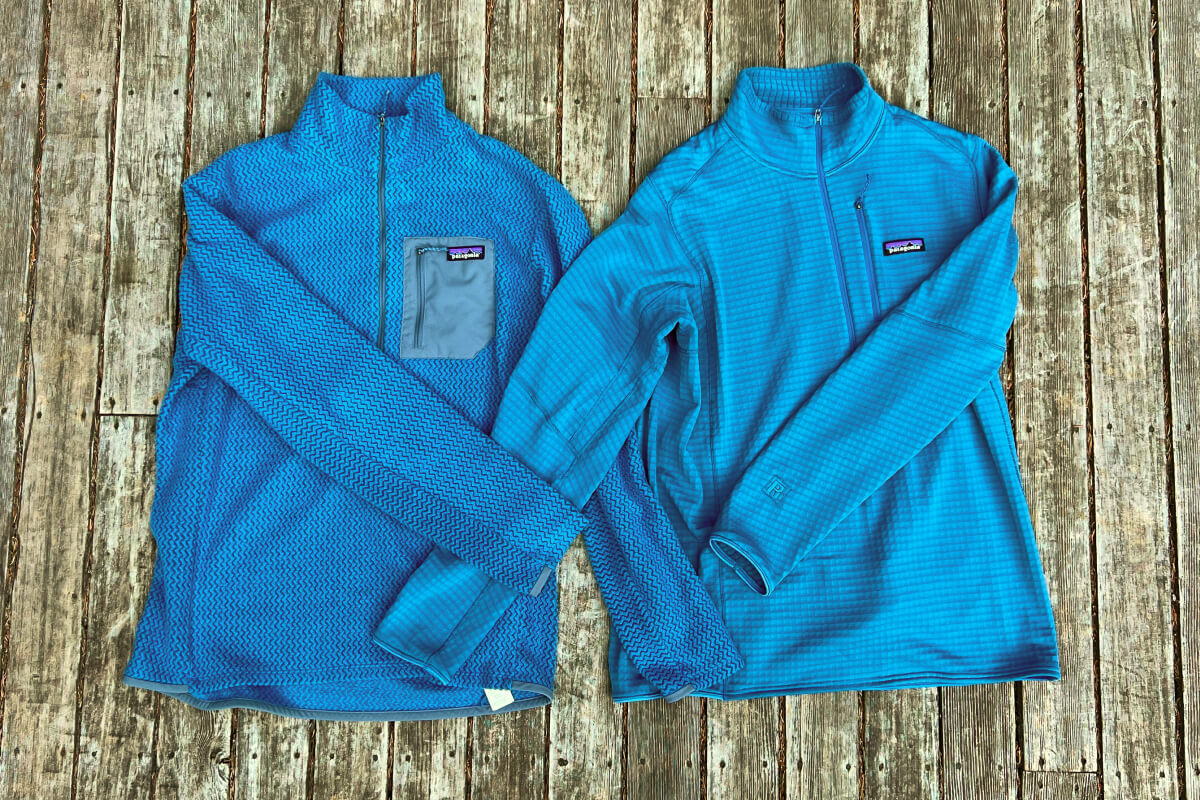
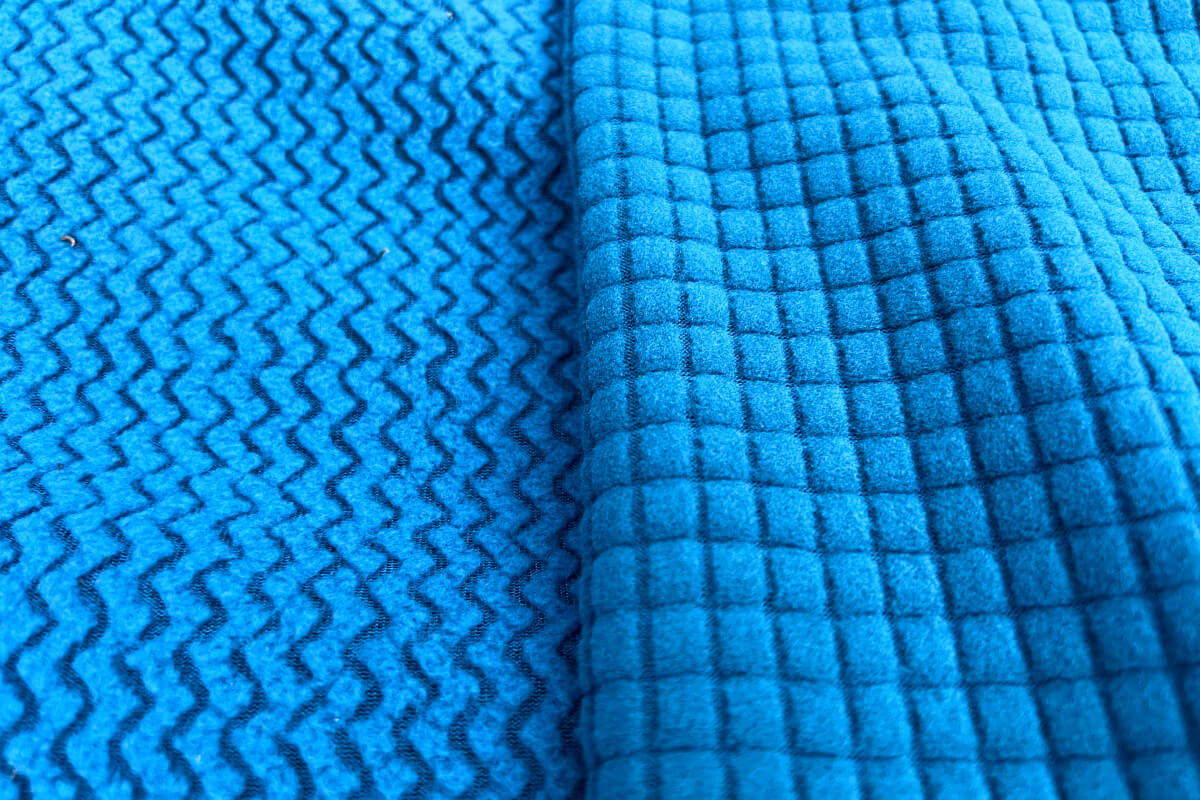
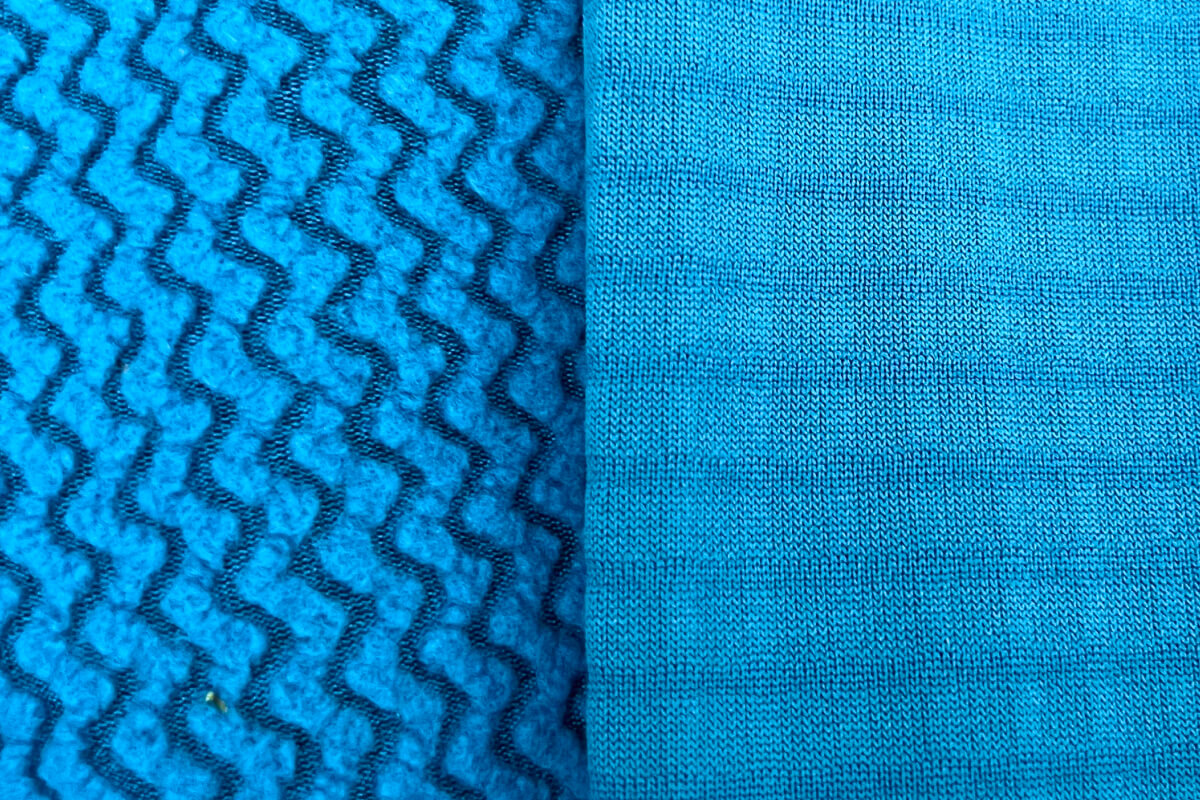
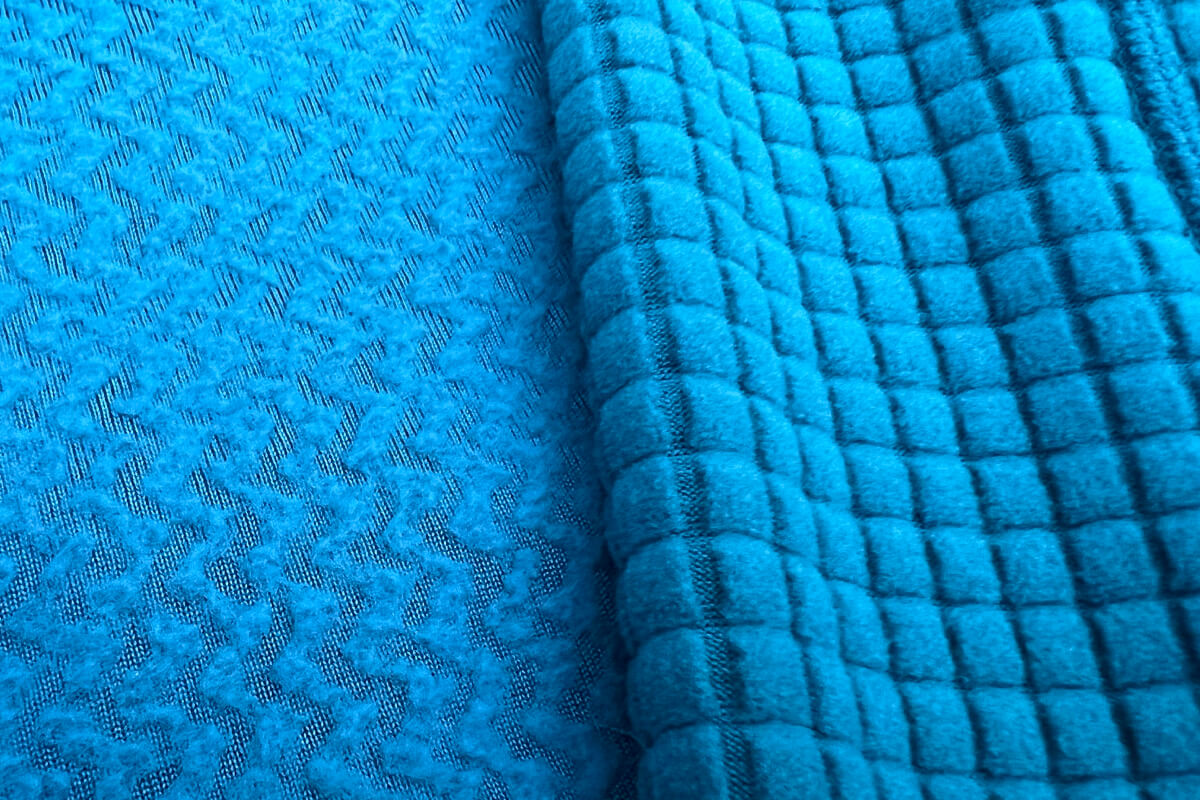
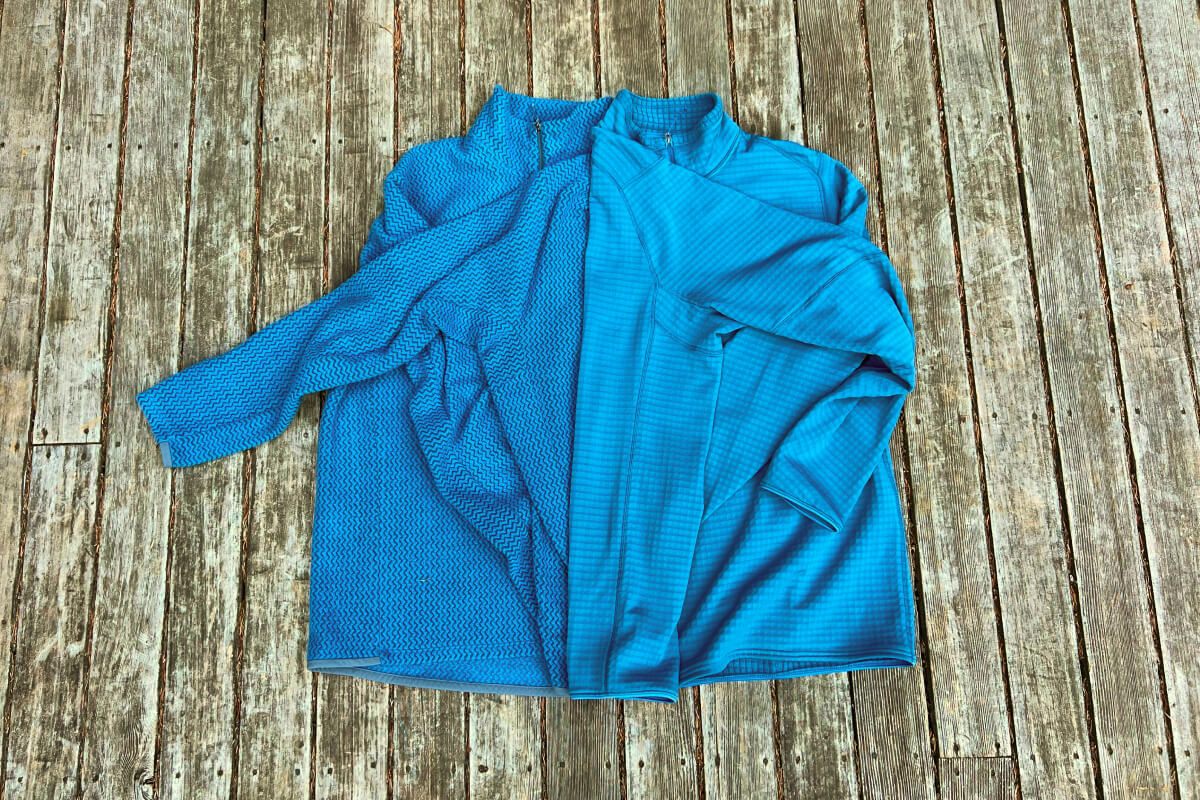
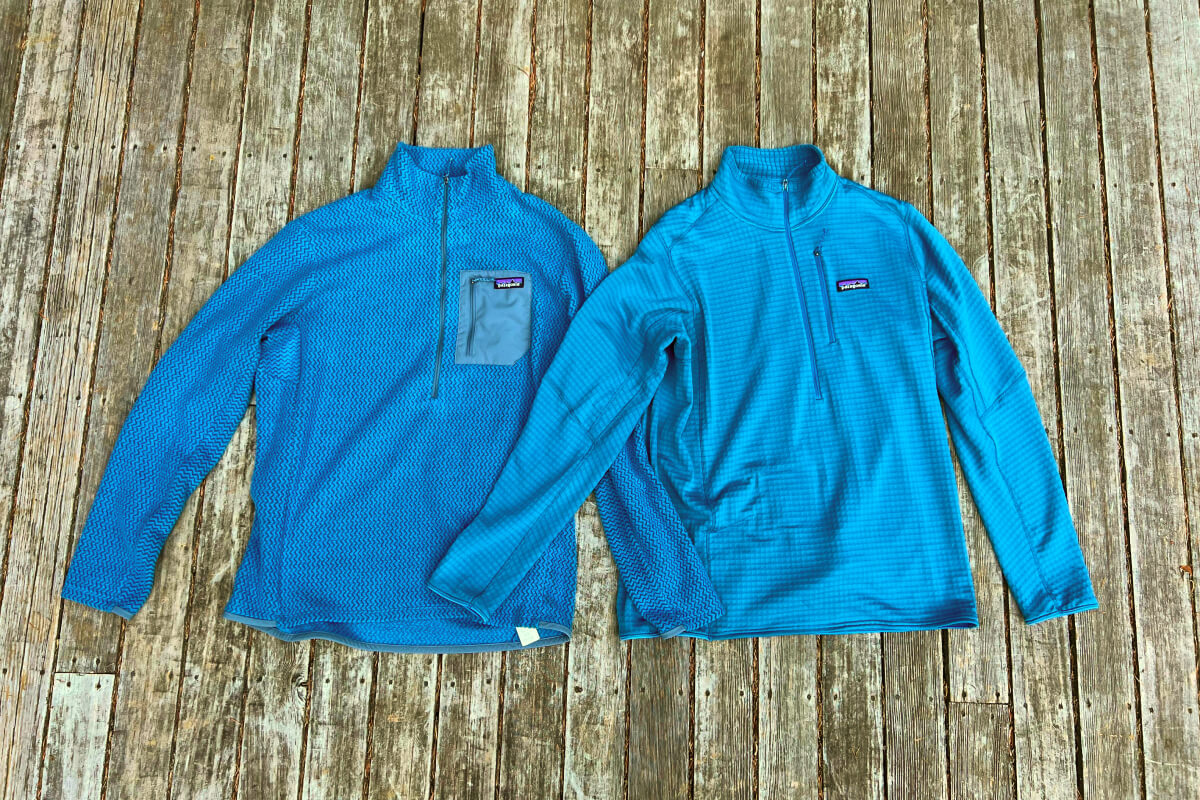


Share this entry